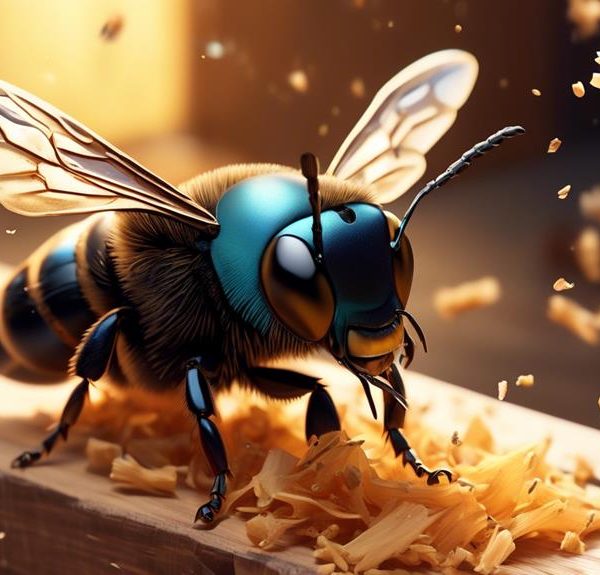Stumble into the intriguing world of carpenter bees and uncover the mystery behind their territorial battles and potential deadly encounters.
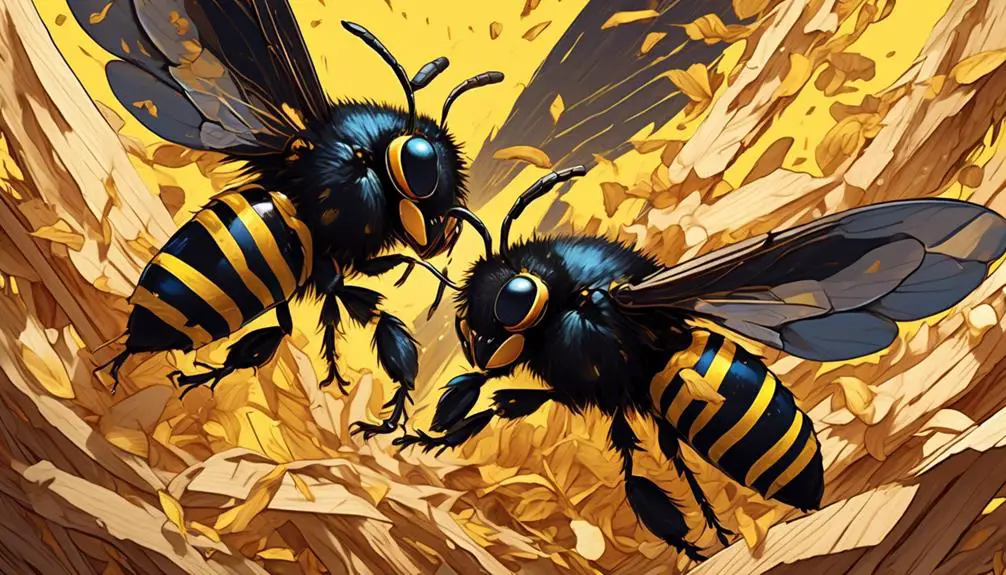
Do Carpenter Bees Kill Each Other
You're likely familiar with the sight of carpenter bees buzzing around wood structures, but you might not know that these solitary insects can exhibit aggression towards one another. They're known for their territorial behavior, often seen in males who guard their territory vigorously.
But does this aggression translate into deadly conflict within the species? As we explore the world of these fascinating creatures further, we'll discover the truth behind their territorial tendencies and whether or not they lead to fatal encounters.
Key Takeaways
- Carpenter bees are primarily solitary insects that excavate nests in wood.
- Male carpenter bees exhibit territorial behavior and protect their territory from intruders.
- Conflict among carpenter bees is generally resolved through bluffing tactics and peaceful resolution rather than physical harm.
- Interactions and conflicts within carpenter bee populations can impact population dynamics and have indirect effects on the ecosystem.
Understanding Carpenter Bee Behavior
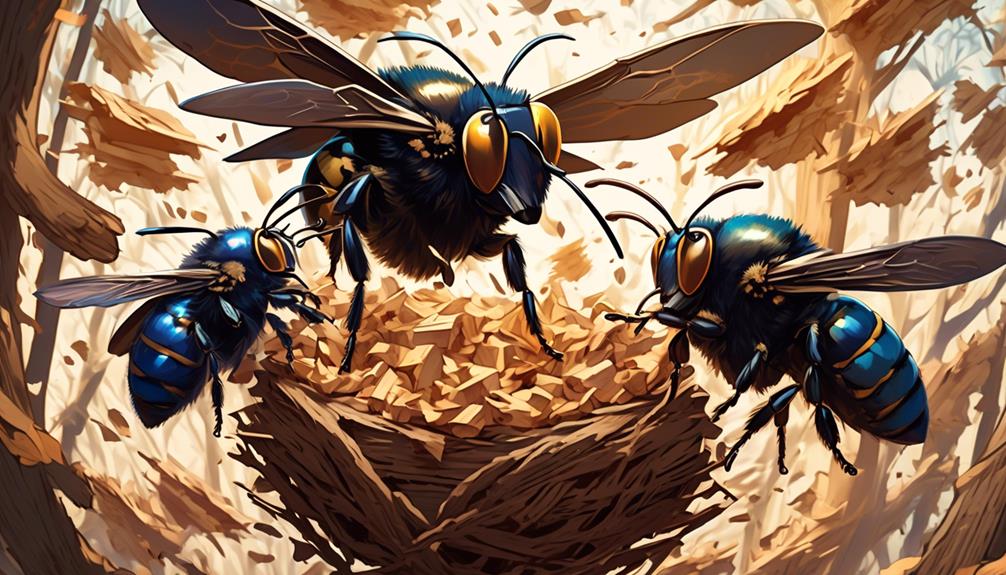
Although you may perceive carpenter bees as a nuisance, understanding their behavior can shed light on their crucial role in the ecosystem and provide insights for better management of these creatures. Unlike their social counterparts, the honeybees, carpenter bees are solitary insects. They're not hive dwellers; they excavate nests in wood, creating circular holes which lead to a network of tunnels.
Each female carpenter bee is fertile and builds her nest independently, usually in spring. You'll notice the female's laborious work as she uses her strong mandibles to carve out her nest. This labor can cause significant damage to wooden structures, hence the perceived nuisance. However, it's important to understand that they're not eating the wood but merely removing it, unlike termites.
Males, on the other hand, don't have the ability to sting. Their primary role is to mate and protect their territory. They're known for their aggressive flight patterns when humans approach their nests. But don't be alarmed, it's more of a defensive bluff than an actual threat.
Carpenter Bees: Social or Solitary?
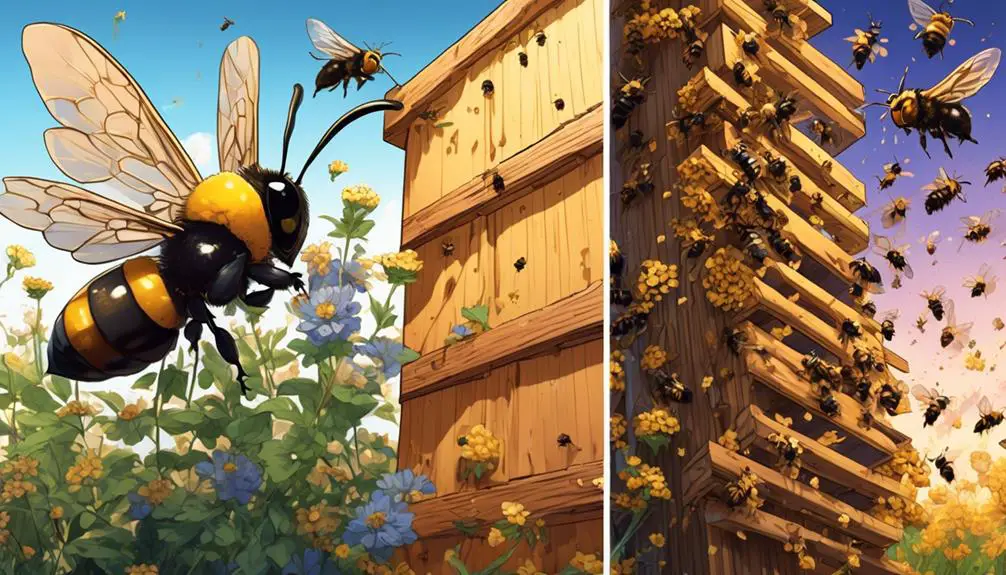
Despite their solitary nesting habits, you might find it surprising that carpenter bees aren't entirely antisocial, often interacting with other bees in their vicinity. In fact, they exhibit a mixture of both solitary and social characteristics.
Unlike honeybees or bumblebees, carpenter bees don't form large colonies. Instead, they're primarily solitary, with females digging individual nests in wood and providing for their own offspring. However, they aren't strictly solitary. Male carpenter bees, which don't have the ability to sting, are often found hovering near nests, protecting their territory and waiting for opportunities to mate.
In a peculiar form of social interaction, offspring of the same mother will often remain near their birth nest and interact with each other, exhibiting a sense of familial bond. These interactions, though, are limited and don't form a complex social structure like in hive bees.
Furthermore, there's evidence of parasitic behavior, where certain female carpenter bees might invade another's nest, kill the resident eggs or larvae, and replace them with their own. This isn't a common trait, but it's a clear demonstration that carpenter bees' social interactions can be diverse and complex.
Aggression and Territorial Tendencies
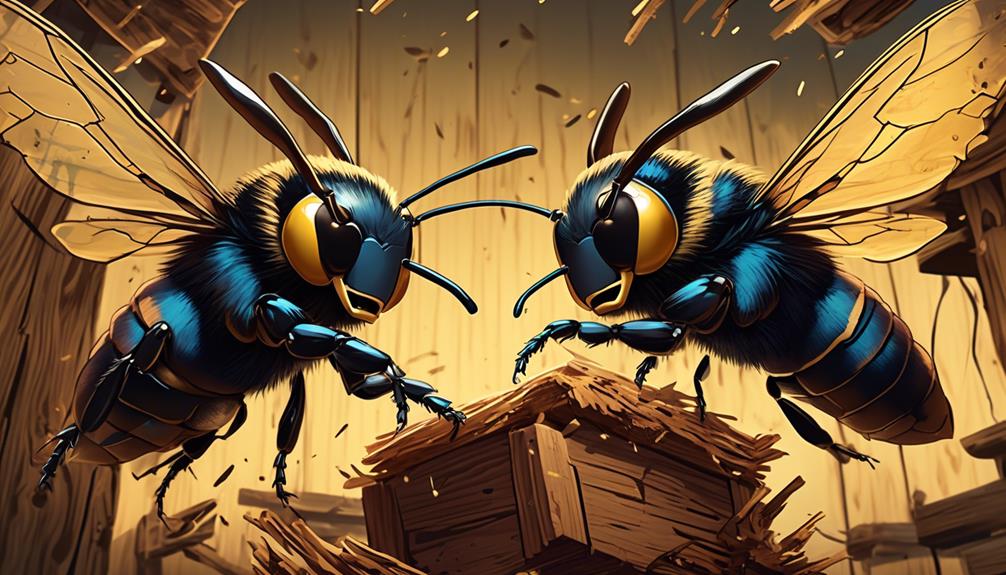
Diving into the realm of aggression and territorial tendencies, you'll find that carpenter bees exhibit a fascinating display of these behaviors as part and parcel of their survival strategy. Primarily solitary, these insects are fiercely protective of their nests, which they meticulously carve out in wood. Male carpenter bees, despite lacking stingers, are particularly aggressive in their defense.
You'd think that this aggression would lead to fatalities, but that's rarely the case. Male carpenter bees often engage in aerial displays of dominance, attempting to intimidate intruders with their size and speed. It's more posturing than actual physical confrontation. They're trying to ward off potential threats without risking injury.
Females, on the other hand, are equipped with stingers but exhibit aggression only when they perceive a direct threat to their nests. They prefer to avoid conflict, focusing instead on their primary tasks of nest construction and offspring rearing.
In terms of territoriality, carpenter bees typically claim a small area surrounding their nests. Intruders are promptly chased away, ensuring the safety of the nest and the continuity of the carpenter bee's lineage. So, while they don't usually kill each other, carpenter bees certainly aren't pushovers either.
Conflict Resolution Among Carpenter Bees
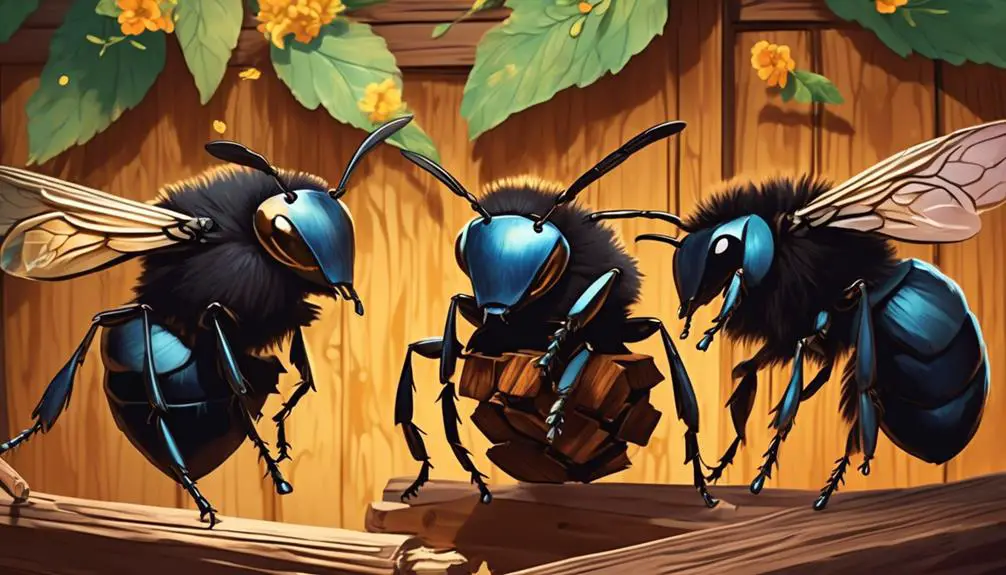
When it comes to conflict resolution among carpenter bees, you'll find that these insects employ a variety of strategies to maintain peace and avoid unnecessary physical altercations. Male carpenter bees, despite being incapable of stinging, often display aggressive behavior, such as dive-bombing or hovering, to ward off potential threats.
However, actual physical harm is rare. Instead, these actions are mostly bluffing tactics, designed to intimidate rather than injure. If the perceived threat doesn't retreat, the bees typically fly off, opting for avoidance rather than a risky encounter.
Females, on the other hand, are more docile unless their nest is in danger. If disturbed, they may resort to stinging but this is usually a last resort. They'd rather invest their energy in caring for their brood than engaging in conflicts.
Interestingly, intraspecies conflicts are also resolved with minimal violence. When two bees vie for the same nesting site, they'll engage in a 'dance-off', buzzing around each other until one gives up and leaves. This ritualistic behavior highlights the complex social dynamics of carpenter bees, indicating a preference for peaceful resolution over violent confrontation.
Impact of Inter-Bee Conflict on Populations

Building on this awareness of conflict resolution strategies in carpenter bees, it's crucial to consider the broader implications these interactions have on overall bee populations. Interactions, particularly conflicts, within a species can significantly impact population dynamics.
In the case of carpenter bees, conflicts can lead to death or injury, reducing the number of reproductive individuals and potentially limiting population growth. However, these conflicts also enforce a social structure that ensures only the strongest and most fit individuals reproduce, thereby contributing to the overall health of the population.
When you consider the wider ecology, inter-bee conflicts can also have indirect effects. For instance, a decrease in the population of carpenter bees due to internal conflicts can disrupt the pollination processes they contribute to, impacting plant reproduction and the broader ecosystem they inhabit.
On the flip side, if conflict resolution mechanisms are effective and prevent excessive bee deaths, they may contribute to population stability. Understanding these dynamics is essential for both bee conservation efforts and the maintenance of the ecosystems they support.
Thus, while conflict among carpenter bees may seem detrimental, it's a complex interplay of factors that can both harm and benefit bee populations.
Conclusion
In sum, you'll find that carpenter bees, while primarily solitary, exhibit certain territorial tendencies. However, they don't typically kill each other. Conflicts are often resolved through displays of aggression rather than deadly fights.
This behavior impacts their populations minimally, ensuring their survival and continuation.
So, next time you spot a carpenter bee, remember, they're more interested in woodwork than warfare.


